How To Change Your Height In Robloxian High School
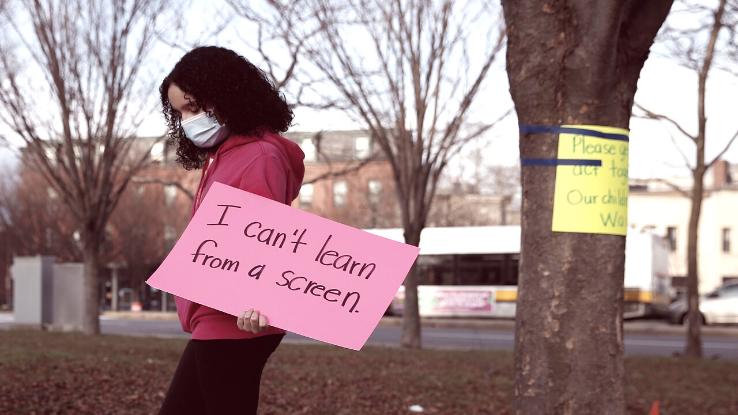
The word "unprecedented" has been thrown around a lot over the concluding year, but it'south hard to pinpoint another discussion that captures simply how much COVID-19 has changed the world. For example, since March 2020, educators have found themselves in the middle of a public health crisis — and scrambling to transition their classes into online courses at the final possible moment.
At the Thousand-12 level, virtually schools, especially public schools, didn't have roadmaps to deal with all-virtual learning scenarios, despite teachers' best efforts. Fifty-fifty privately funded schools and universities with seemingly huge endowments were ill-equipped to surmount technological roadblocks and or assistance students who were suddenly searching for housing and support — financial and otherwise.
It'due south articulate that the ramifications of the COVID-19 pandemic extend far beyond a canceled March Madness tournament, Zoom-hosted classes, and graduation gatherings held on Animal Crossing. As the back-to-schoolhouse season begins in earnest, it's of import to reflect on the myriad ways COVID-19 has impacted our pedagogy system.
How Did K-12 Schools React to the COVID-xix Pandemic?
When the COVID-19 pandemic first swelled in 2020, many students in Yard-12 learning environments were sent abode and, for the rest of the schoolhouse yr, learned from home. Given the lack of clear information surrounding COVID-19, this seemed like the most logical course of action. For case, buses and hallways to cafeterias and classrooms, schools aren't fix to accommodate social distancing practices — and sanitizing and protective equipment, like masks or plastic shields, costs quite a fleck.
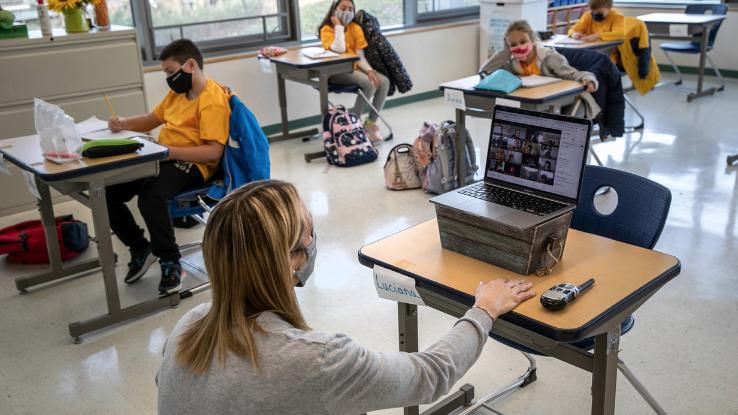
Unfortunately, however, schools' resources are limited when information technology comes to supporting distanced learning besides. Although Zoom and Google Classroom are wonderful resources, they just aren't accessible or feasible for all students, teachers and parents. Sometimes there'southward just no replacement for the existent bargain, and, in this case, that's in-person learning. Over the summer, in the pb-up to the 2020-21 school yr, arguments broke out about the best course of activity.
In New York City, for example, the decision to close public schools in 2020 was a difficult one. On one hand, keeping schools open would've been a health risk for students, teachers and their corresponding households. But, on the other hand, many students rely on their schools for resources or, but, equally places to go when their parents are at work. "Our public educational activity system is a massive hidden child care subsidy," Jon Shelton, a historian of the instruction workforce at the Academy of Wisconsin, told The New York Times.
That is, for some students, school libraries are the simply places they tin can access online resource, books and other school materials. And for students with disabilities, where classrooms are frequently staffed with paraprofessionals or one-on-one aids, distanced learning poses a number of additional challenges. Perhaps well-nigh urgently, many students rely on meals from their schools; parents who tin't afford breakfast and lunch can observe a partner in school cafeterias, which oftentimes offer meals to students from low-income families during the summer equally well, even when school is out.
Following that line of thinking, Seattle-based omnibus commuter Treva White and nutritionist Shaunté Fields started delivering breakfast and lunch to children and their families. Since the COVID-xix schoolhouse closures, the Seattle Public Schools and Nutrition Services Section have worked to distribute meals to approximately 30,000 people per twenty-four hours, including on weekends. Needless to say, schools are essential parts of students' lives and communities — even across learning.
How Did the COVID-19 Pandemic Touch Students & Teachers?
When schools in New York Urban center reopened in the fall, there was a lot of mixed messaging — and 11th-hour decisions — from local officials. Part of that may accept been the rather malleable guidelines the Centers for Disease Command and Prevention (CDC) provided in regards to reopening, but, on the other manus, leadership beyond the land has waffled throughout the pandemic when it comes to reopening schools and businesses.
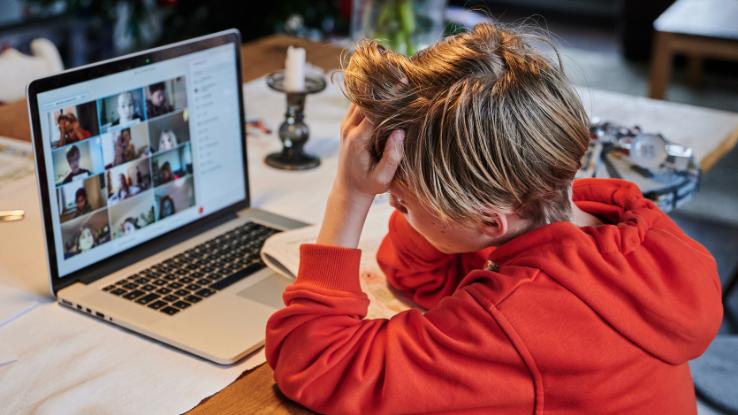
In the end, many schools in New York City opted for a mix of in-person and virtual learning to aid mitigate the myriad concerns associated with social distancing practices. Nearby, in Stamford, Connecticut, public schools implemented alternating days of altitude learning and in-person learning. With this hybrid approach, fewer students learn from home total time, which is seemingly a good way to address concerns parents may have about the quality of their kids' teaching — concerns that spawned protests across the land.
But this button to reopen schools put i major concern onto the back-burner: the toll reopening would accept on teachers and other educational professionals — and, of course, the risk. While the CDC has establish that "about children with COVID-19 accept balmy symptoms or have no symptoms at all," some have nevertheless contracted astringent cases — not to mention, schools could become huge vectors for spreading the virus to students' and teachers' households. Disturbingly, in states that were more than severely impacted by the COVID-xix pandemic, teachers drafted wills and obituaries ahead of the school year.
In August 2020, the White Business firm formally declared teachers essential workers, noting that they are "critical infrastructure workers" — or, in other words, disquisitional to the infrastructure of reopening the country and bolstering the economy. However, unlike other essential workers, teachers don't accept the training and background to mitigate all of these public health concerns, nor exercise they accept the funding, in almost cases, for PPE and other essential, virus-combating supplies. In some states, teachers are expected to receive vaccines early on in the rollout process, but this doesn't concur true beyond every country, nor does it guarantee their safety.
It's indisputable that teachers are essential members of our communities, merely they are also people who, just like all of us, are navigating the horrors of this pandemic. Often, they go across the call of their job descriptions — even outside of the classroom. "My students accept lost family members, and there'due south a lot of trauma we are not addressing," Jessyca Mathews, an English teacher at Carman-Ainsworth High School in Flintstone, Michigan, told Time. "When COVID hit, I had kids who were texting me in the middle of the night, and I answered them every single time."
How Did Colleges & Universities React to the COVID-19 Pandemic?
When it comes to the closure of college campuses, folks seem more than attuned to the other issues that stem from such decisions. Some full-time students who live on campus had nowhere else to go, while others faced daunting fiscal challenges without on-campus jobs or resources similar meal plans. Some students depend on their universities for healthcare — not merely insurance, simply for therapy and onsite checkups. Merely merely because there was an sensation, doesn't mean at that place was an infrastructure in place to assistance students.
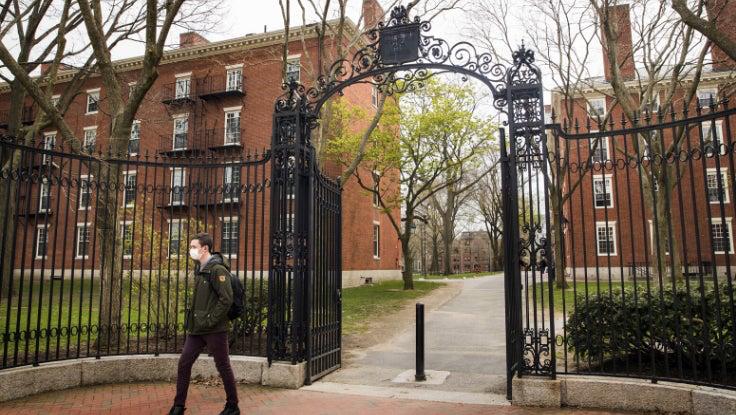
Amid all of those frustrations was the permanent closure of some schools, particularly liberal arts colleges. In May 2020, MacMurray College in Illinois announced its closure afterwards 174 years spent educating students — and information technology's non the just liberal arts school, wanting for the endowments of larger universities, that was forced to shutter. And with as many as 44.7 million Americans owing a total of over $one.71 trillion in educatee loan debt, it's clear that this model isn't working for anyone.
"Higher education is not nimble. We are steeped in tradition, and nosotros are not always able to motility as speedily as we demand to," Beverly Rodgers, president of MacMurray College, a modest, private liberal arts college in Jacksonville, Illinois, told WBUR. "There needs to be a remake of higher didactics as a business organization model, in my stance."
In March 2020, the CARES federal relief package allowed Congress to allocate almost $14 billion for colleges and universities — an amount that the American Council on Education called "woefully inadequate." The group'due south ask? They, and dozens of college ed organizations, believe at least $46 billion is needed.
Needless to say, colleges and universities institute other ways to cope. Pine Manor College, a pocket-sized private establishment in Chestnut Loma, Massachusetts, that aims to support underserved and low-income students, merged with the much larger Boston Higher and the University of Akron eliminated iii intercollegiate sports from its roster, resulting in a reported $4.four million in savings, as well every bit half-dozen of its 11 bookish colleges.
How Has the COVID-19 Pandemic Inverse Higher Didactics?
Unfortunately, novel coronavirus outbreaks were linked to college "fraternities, sororities and off-campus parties," leading to stricter requirements — and consequences — for students who alive on campus and nourish in-person classes. While all-virtual classes would mitigate this risk (and temptation), some institutions feared that students wouldn't exist willing to shell out full tuition costs for online-but offerings.
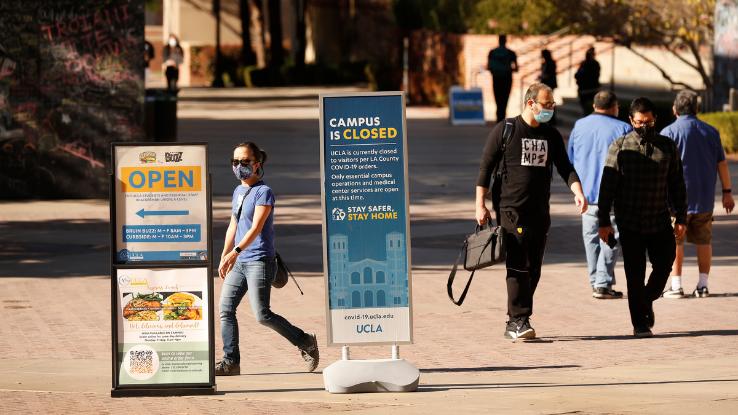
Many colleges and universities tried hybrid approaches to cutting downwards on large classes and account for the number of students on campus and in communal spaces at i time. The Academy of California, Los Angeles (UCLA) housed just 700 students and a few members of staff during the 2020-21 academic year. Additionally, the school also closed its campus to the public and redeployed UCLA food service workers to fix meals for depression-income families in the surface area (via Los Angeles Times). All of this came amid huge financial losses to the UC school organization.
Simply, undeniably, we've also learned that there are some upsides to virtual learning. For case, for students who live at home, or couldn't beget cross-land moves and housing, virtual models brand college potentially more accessible and affordable. So, volition the scheduling milk shake-ups and focus on virtual classes last longer than the pandemic? At this point, the mark the pandemic has fabricated — and the cracks it has made more apparent — seems indelible.
Source: https://www.reference.com/world-view/life-after-covid19-education-college-schools?utm_content=params%3Ao%3D740005%26ad%3DdirN%26qo%3DserpIndex
Posted by: sargentthoreeduck.blogspot.com

0 Response to "How To Change Your Height In Robloxian High School"
Post a Comment